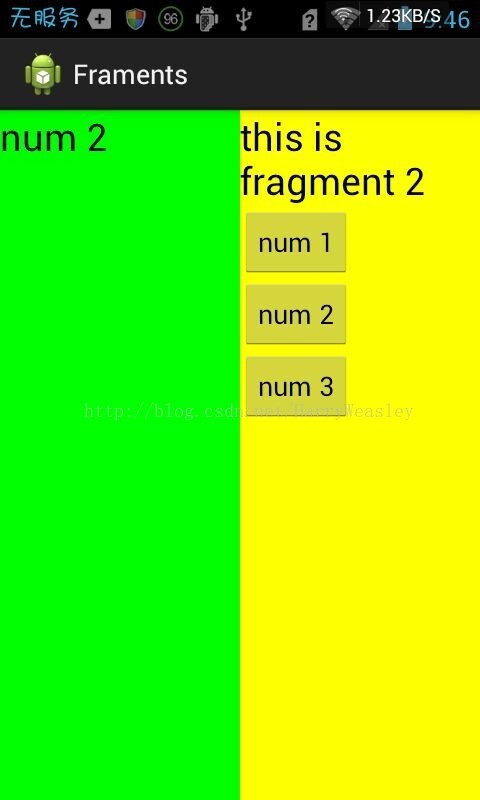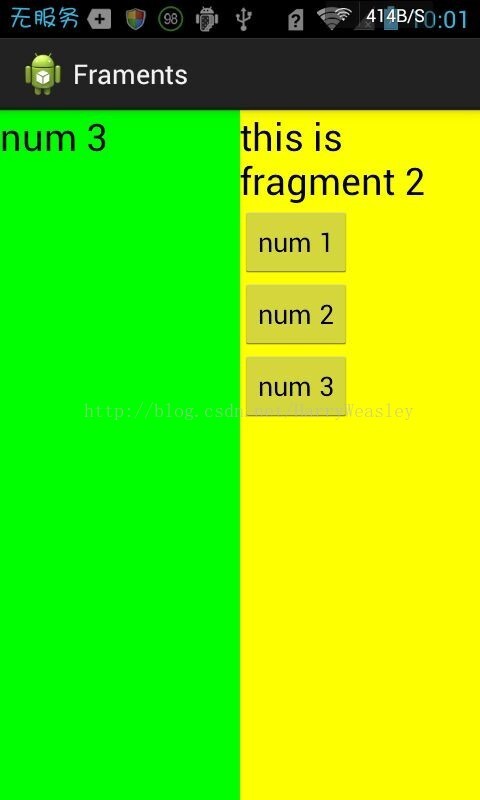Android应用开发中Fragment与Activity间通信示例讲解
发布于 2017-09-28 03:07:59 | 160 次阅读 | 评论: 0 | 来源: 网友投递
Android移动端操作系统
Android是一种基于Linux的自由及开放源代码的操作系统,主要使用于移动设备,如智能手机和平板电脑,由Google公司和开放手机联盟领导及开发。尚未有统一中文名称,中国大陆地区较多人使用“安卓”或“安致”。
这篇文章主要介绍了Android应用开发中Fragment与Activity间通信实例讲解,需要的朋友可以参考下
首先,如果你想在android3.0及以下版本使用fragment,你必须引用android-support-v4.jar这个包
然后你写的activity不能再继承自Activity类了,而是要继承android.support.v4.app.FragmentActivity,一些其他的父类也有相应的变化.
由于在android的实现机制中fragment和activity会被分别实例化为两个不相干的对象,他们之间的联系由activity的一个成员对象fragmentmanager来维护.fragment实例化后会到activity中的fragmentmanager去注册一下,这个动作封装在fragment对象的onAttach中,所以你可以在fragment中声明一些回调接口,当fragment调用onAttach时,将这些回调接口实例化,这样fragment就能调用各个activity的成员函数了,当然activity必须implements这些接口,否则会包classcasterror
fragment和activity的回调机制又是OOP的一次完美演绎!
下面通过一个例子来说明:
首先,我们看下界面


左边的TextView会根据右边点击button的不同而改变。
下面开始介绍代码:
1.在layout里新建fragment1.xml
<?xml version="1.0" encoding="utf-8"?>
<LinearLayout xmlns:android="http://schemas.android.com/apk/res/android"
android:layout_width="match_parent"
android:layout_height="match_parent"
android:background="#00ff00"
android:orientation="vertical" >
<TextView
android:id="@+id/fragment_text"
android:layout_width="wrap_content"
android:layout_height="wrap_content"
android:text="this is fragment 1"
android:textColor="#000000"
android:textSize="25sp" />
</LinearLayout>
可以看出,这里就只有一个TextView
2.在layout里新建fragment2.xml
<?xml version="1.0" encoding="utf-8"?>
<LinearLayout xmlns:android="http://schemas.android.com/apk/res/android"
android:layout_width="match_parent"
android:layout_height="match_parent"
android:background="#ffff00"
android:orientation="vertical" >
<TextView
android:layout_width="wrap_content"
android:layout_height="wrap_content"
android:text="this is fragment 2"
android:textColor="#000000"
android:textSize="25sp" />
<Button
android:id="@+id/button"
android:layout_width="wrap_content"
android:layout_height="wrap_content"
android:text="num 1" />
<Button
android:id="@+id/button2"
android:layout_width="wrap_content"
android:layout_height="wrap_content"
android:text="num 2" />
<Button
android:id="@+id/button3"
android:layout_width="wrap_content"
android:layout_height="wrap_content"
android:text="num 3" />
</LinearLayout>
这里是三个button
3.创建类Fragment1继承Fragment
package lgx.fram.framents;
import android.app.Fragment;
import android.os.Bundle;
import android.view.LayoutInflater;
import android.view.View;
import android.view.ViewGroup;
public class Fragment1 extends Fragment {
@Override
public View onCreateView(LayoutInflater inflater, ViewGroup container,
Bundle savedInstanceState) {
return inflater.inflate(R.layout.fragment1, container, false);
}
}
重写onCreateView()方法,这里 return inflater.inflate(R.layout.fragment1, container, false); 这句话是重点
4.创建类Fragment2继承Fragment
package lgx.fram.framents;
import android.app.Fragment;
import android.os.Bundle;
import android.view.LayoutInflater;
import android.view.View;
import android.view.View.OnClickListener;
import android.view.ViewGroup;
import android.widget.Button;
import android.widget.TextView;
public class Fragment2 extends Fragment {
@Override
public View onCreateView(LayoutInflater inflater, ViewGroup container,
Bundle savedInstanceState) {
return inflater.inflate(R.layout.fragment2, container, false);
}
TextView textview;
Button button, button2, button3;
@Override
public void onActivityCreated(Bundle savedInstanceState) {
super.onActivityCreated(savedInstanceState);
button = (Button) getActivity().findViewById(R.id.button);
button2 = (Button) getActivity().findViewById(R.id.button2);
button3 = (Button) getActivity().findViewById(R.id.button3);
textview = (TextView) getActivity().findViewById(R.id.fragment_text);
button.setOnClickListener(new OnClickListener() {
@Override
public void onClick(View v) {
textview.setText(button.getText());
}
});
button2.setOnClickListener(new OnClickListener() {
@Override
public void onClick(View v) {
textview.setText(button2.getText());
}
});
button3.setOnClickListener(new OnClickListener() {
@Override
public void onClick(View v) {
textview.setText(button3.getText());
}
});
}
}
button = (Button) getActivity().findViewById(R.id.button);
通过这种方法来得到fragment上面的控件
5.activity_fragment.xml里面的代码是这个样子的
<?xml version="1.0" encoding="utf-8"?>
<LinearLayout xmlns:android="http://schemas.android.com/apk/res/android"
android:id="@+id/main_layout"
android:layout_width="match_parent"
android:layout_height="match_parent"
android:baselineAligned="false"
android:orientation="horizontal" >
<fragment
android:id="@+id/fragment1"
android:name="lgx.fram.framents.Fragment1"
android:layout_width="match_parent"
android:layout_height="match_parent"
android:layout_weight="1" />
<fragment
android:id="@+id/fragment2"
android:name="lgx.fram.framents.Fragment2"
android:layout_width="match_parent"
android:layout_height="match_parent"
android:layout_weight="1" />
</LinearLayout>
注意:控件fragment里的android:name=" "里面填写的是你的Fragment类的绝对路径(脑子突然短路,是这样说的吗??),id用来标示fragment。
6.FragmentActivity是最简单的,就只是setContentView,并没有进行其他改变。看下面
package lgx.fram.framents;
import android.app.Activity;
import android.os.Bundle;
public class FragmentActivity extends Activity {
@Override
protected void onCreate(Bundle savedInstanceState) {
super.onCreate(savedInstanceState);
setContentView(R.layout.activity_fragment);
}
}
在这里我的整个小应用就做完了。我这里的Fragment通过布局文件加入到Activity里的,还有另一种方式是通过编程的方式将Fragment加入Activity里。这里我简单叙述
上面的1,2,3,4都不需要动。
第5步骤,activity_fragment.xml里面的代码变成下面的
<?xml version="1.0" encoding="utf-8"?>
<LinearLayout xmlns:android="http://schemas.android.com/apk/res/android"
android:id="@+id/main_layout"
android:layout_width="match_parent"
android:layout_height="match_parent"
android:baselineAligned="false"
android:orientation="horizontal" >
</LinearLayout>
你会发现我知识去掉了两个Fragment,整个LinearLayout加进去了id
第6个步骤,里面的注释,已经写得很清楚了:
package lgx.fram.framents;
import android.os.Bundle;
import android.app.Activity;
import android.view.Display;
import android.view.Menu;
@author lenovo 动态添加Fragment主要分为4步:
(1)获取到FragmentManager,在Activity中可以直接通过getFragmentManager得到。
(2)开启一个事务,通过调用beginTransaction方法开启。
(3)向容器内加入Fragment,一般使用replace方法实现,需要传入容器的id和Fragment的实例。
(4)提交事务,调用commit方法提交。
public class FragmentActivity extends Activity {
@Override
protected void onCreate(Bundle savedInstanceState) {
super.onCreate(savedInstanceState);
setContentView(R.layout.activity_fragment);
Display display = getWindowManager().getDefaultDisplay();
if (display.getWidth() > display.getHeight()) {
Fragment1 fragment1 = new Fragment1();
getFragmentManager().beginTransaction()
.replace(R.id.main_layout, fragment1).commit();
} else {
Fragment2 fragment2 = new Fragment2();
getFragmentManager().beginTransaction()
.replace(R.id.main_layout, fragment2).commit();
}
}
}
这个代码的意思是,横竖屏显示不同的Fragment。如果是模拟机测试,请按Ctrl+F11。